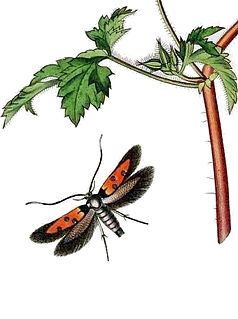
The Agonoxeninae are a subfamily of moths.
The Cosmopterigidae are a family of insects in the order Lepidoptera. These are small moths with narrow wings whose tiny larvae feed internally on the leaves, seeds, stems, etc. of their host plants. About 1500 species are described. The taxonomic family is most diverse in the Australian and Pacific region with about 780 species.

The Momphidae, or mompha moths, is a family of moths with some 115 described species. It was described by Gottlieb August Wilhelm Herrich-Schäffer in 1857. These moths tend to be rather small with a wingspan of up to 21 mm. The wings are held folded over the body at rest. The larvae are concealed feeders, either as leaf miners or within seeds or stems.

Eteobalea intermediella is a moth of the family Cosmopterigidae. It is native to an area ranging from Central and Southern Europe, east to the Caucasus, Asia Minor, the Near and Middle East towards Central Asia. It is also present in North Africa. It has been introduced to the United States and Canada.
Scaeosopha is a genus of moths in the family Cosmopterigidae.

Hyposmocoma auropurpurea is a species of moth of the family Cosmopterigidae. It was first described by Lord Walsingham in 1907. It is endemic to the Hawaiian island of Oahu. The type locality is the Waianae Range.

Hyposmocoma inversella is a species of moth of the family Cosmopterigidae. It was first described by Lord Walsingham in 1907. It is endemic to the Hawaiian island of Oahu. The type locality is the Waianae Range, where it was collected at an elevation of 2,000 feet (610 m).

Hyposmocoma nebulifera is a species of moth of the family Cosmopterigidae. It was first described by Lord Walsingham in 1907. It is endemic to the Hawaiian island of Oahu. The type locality is the Waianae Range, where it was collected at an elevation of 2,000 feet (610 m).
Hyposmocoma papahanau is a species of moth of the family Cosmopterigidae. It is endemic to Nihoa, Northwestern Hawaiian Islands. The type locality is Miller Canyon.
Vulcaniella extremella is a moth of the family Cosmopterigidae. It is found from Poland to the Iberian Peninsula, Italy, and Bulgaria and from France to central and southern Russia.
Vulcaniella grabowiella is a moth of the family Cosmopterigidae. It is found from the Iberian Peninsula to Asia Minor.
Ascalenia kabulella is a moth in the family Cosmopterigidae. It is found in Afghanistan.

The Antequerinae are a subfamily of the Cosmopterigidae. In the Nearctic, the subfamily consists of eight species in four genera, found in North America and England.
Cosmopterix salahinella is a moth of the family Cosmopterigidae. It is found from Tunisia, Egypt, Libya and Israel east to Saudi Arabia and Iran.
Pyroderces apicinotella is a moth in the family Cosmopterigidae. It is found in Tunisia, Libya and Iraq.
Anatrachyntis coridophaga is a moth in the family Cosmopterigidae. It is found in Egypt and Libya.
Hodgesiella christophi is a moth of the family Cosmopterigidae that is endemic to Asia Minor.
Calycobathra acarpa is a moth in the family Cosmopterigidae. It is found in North Africa (Algeria) and the Near East (Israel).






